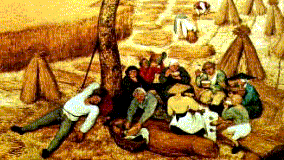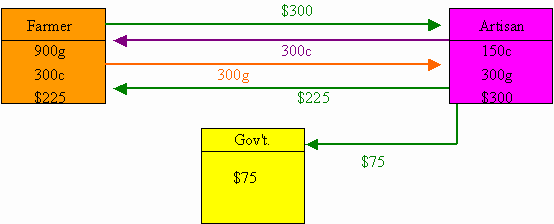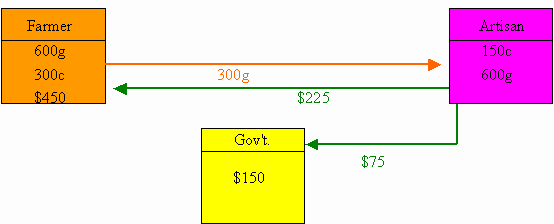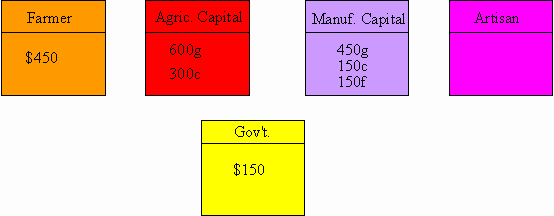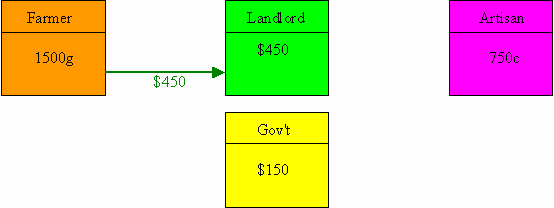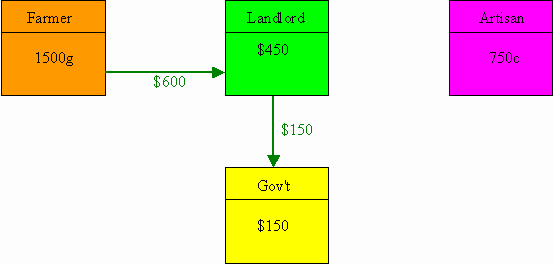|
___________________________________________________________ "‘I?’ said [the merchant], ‘I contribute to the needs of the State? You are poking fun, my friend; I have succeeded an uncle who had gained eight millions at Cadiz and Surat; I have not an inch of land: all my property is in securities; I owe the State nothing; it is for you who are a landed gentleman to give half of your subsistence. Do you not see that if the Minister of Finance required of me some assistance for the country he would be a misguided idiot; for everything comes from the land;.... . If, after putting the impôt unique on these commodities, they were still to ask me for money, do you not understand that they would be getting it twice over?... How horrible! Pay, my friend, you who enjoy in peace a clear and net income of forty crowns, serve well your country, and come now and then to dine with my servants.’" (Voltaire, l'Homme au quarante ecus) ___________________________________________________________ Contents (1) Rent and the Surplus According to the Physiocrats, all taxes, no matter their structure, ultimately fall upon the net product. It was one of the principal novelties of their theory that the legal taxpayer was not the actual taxpayer, but rather that the tax burden would get shifted around until it landed on the net product. For this reason, replacing all taxes by a Single Tax on land rents would be the most efficient method of taxation. In this section we will analyze this argument a little more closely. (1) Rent and the Surplus In our earlier numerical example, we noted that the Landlord takes the Farmer's entire net product of $600 in the form of land rents. Why does he do so? Because he can. Quesnay and the Physiocrats were among the first to advance the idea that rent was not an independent cost of production, but rather a deduction from the surplus after production. Landlords adjust their rents in order to appropriate the farmer's surplus in its entirety. As a result, rent is elastic; it expands or contracts depending upon the size of the surplus. If the farmer's surplus was any greater or any smaller than $600, the Landlords would modify their rents accordingly. Landlords, in the Physiocratic perspective, are parasites. They live off the fortunes of others, but they do not determine these fortunes. If the price of bread is high, it is not because land rents are high; but land rents will be high because the price of bread is high. Adam Smith (1776: Bk. I, Ch. 11) adopted a similar perspective on rent (although he vacillates a bit on this; for more details, see our discussion of rent). (2) The Tax-Equivalence Hypothesis The Physiocrats believed that taxes, too, are ultimately deductions from the surplus. This may not seem obvious, but to the Physiocrats, this was the very essence of their fiscal doctrines and so is worth trying to understand how they "proved" this. Suppose we impose a tax on the sale of grain. Remember, to keep the economy in its self-replicating state, the capital requirements are real and remain real. The Farmer and Artisan need to buy the same amount of goods as before, but their cash does not go quite as far any more because, with the excise tax in place, part of it will be siphoned off by the government. But that does not matter. The Farmer and the Artisan just give to Caesar what belongs to Caesar. At the end of the day, all that will happen is that the Farmer's net product will be less than $600. As the Landlords are residual earners, they will take the remaining fraction. They may grumble about the lower rents received, but they have to put up with it. But that is not all. To accommodate the tax in self-replicating equilibrium, the cash prices of grain and crafts must adjust proportionally to the amount of the tax. For instance, if prices were as before, then a 0.25 excise tax on grain means that a unit of grain now costs $1.25 while a unit of crafts continues to cost $1. Obviously, the self-replicating trades cannot go through. The Artisan's initial $300 will only be able to buy 240 units of grain, which is clearly not enough for his needs. In order to get the 300 grain he needs to set aside for next year, he may try to increase the price of crafts by 0.25. But, in that case, the Farmer's $300 are now only able to buy 240 units of crafts -- which is, in turn, not enough for his needs. The resolution? Reduce the price of grain to $0.75 and keep the price of crafts at $1. Now, the Artisan's $300 will command 300 units of grain (although $60 will go to the Government rather than the Farmer), while the Farmer's $300 will continue to command 300 units of crafts. With the new tax and adjusted prices in place, the aggregate exchange from the zig-zag process is summarized below:
Going on to the capital stage, in the non-reciprocated purchase of grain by the Artisan we have:
After setting all capitals aside (just as before), we see that the final positions are:
So production ensues and the Farmers and Artisans can produce 1500g and 750c respectively. Proceeding as before, the Farmer pays all his net product -- $450 -- as rent to the landlord.
And we are done. Notice that, in the final instance, the positions of the Farmer and the Artisan are exactly as before. What has changed is that the Landlord now collects only $450 of the net product in rents, whereas the Government collects the remaining $150. But the total net product remains $600. But something is amiss. After all, in the original story, the Landlord initially injected $600 because he had $600 in rent. Now, he injects $600 but only collects $450 in rent. So, if we were to repeat this process, he can only inject $450 in the next period -- which will mean a lower rent, etc. Clearly, the economy is not self-replicating any more! Well, not quite -- because the Government will inject the remaining $150. We must assume that the Government's only reason to collect taxes is that it plans to ultimately spend them on purchasing goods from the Farmer and Artisan. The Government must buy carriages, uniforms, ammunition, food, fuel and so on to maintain their Court and Army in fashionable and comfortable style. So, assuming a balanced budget, the Government will spend the $150 it has acquired. So, at the beginning of the next period, Landlord consumption plus Government expenditures are injected into the purchase of grain and crafts and, so the total of $600 cash ($450 rents and $150 taxes) will find their way right back into the economy. The whole system repeats itself and, once again, at the end of the year, $450 return to the Landlord as rents and $150 to the Government as taxes. We do have self-replication. [Note: What if the budget is not balanced? Suppose the government wishes to spend $200, but only has $150? Then it must "borrow" the extra $50 from somewhere. In perfect Ancien régime tradition, it would probably borrow it from the landlord -- voluntarily or (as often happened), forcibly via "benevolences"; it will pay him back when it acquires a surplus.] The main lesson the Physiocrats wanted to impress was this: regardless of the way we levy taxes -- on the sale of grain, sale of crafts, farmer's profits, etc. -- one way or another, the taxes will ultimately bear down on the net product of the agricultural sector. As the Landlord is always the residual earner, then he will have to reduce his rental income to account for this reduction. In short, the burden of the tax always falls upon the Landlord's rental income. We can call this fundamental doctrine the Physiocratic "tax equivalence hypothesis". (3) The Single Tax The Physiocrats famously advocated that all taxes be withdrawn and replaced by a "single tax" (l'impôt unique) on land rents. But if, as argued in their tax equivalence hypothesis, the Physiocrats saw no difference between the incidence of the single tax and other forms of taxes, why bother recommending such a bizarre fiscal overhaul? For several reasons. Remember that in order for the Physiocrats' tax equivalence hypothesis to hold true, we must assume that cash prices adjust instantaneously to their "self-replicating" equilibrium level. But, unlike the later Classical School, the Physiocrats did not have at their disposal (or at least did not employ) a "supply-and-demand" mechanism which would bring market prices to this self-replicating level. In other words, they did not articulate how prices would do the necessary adjusting. Some of them mumbled that as the self-replicating price was "natural", then somehow, nature would "impose itself". But they were not very clear about how this would happen and, more importantly, how long it would take. So, suppose that prices do not adjust -- or simply do not adjust fast enough -- to their self-replicating level. Then the economy will go to the dogs in the interim. The pernicious effects of a sudden, mid-year tax hike were laid out by, among others, Dupont de Nemours (1768: p.42-3). Suppose the 0.25 excise tax on grain sales is imposed but that, for some reason or other, grain prices do not adjust to their "self-replicating" equilibrium level of $0.75 but instead remain stuck (temporarily or otherwise) at $1.25. In this case, the Artisan will only be able to buy 240 units of grain and will thus be unable to meet his "self-replicating" needs. There will consequently be short-falls in the production of crafts and further price distortions and misallocations. Until the cash price of grain comes down to its equilibrium level of $0.75, the output of the economy will be less than it would have been without the tax. In the Physiocrats' perspective, these shortfalls, however temporary, are wasteful and unnecessary. They could be completely avoided if the excise tax was replaced by the impôt unique -- the single tax on land rents. With the single tax in place, the cash prices of grain and crafts would remain as in the "natural state" -- i.e. each would cost $1 per unit -- and the whole process would work itself through as if there were no taxes at all. After the harvest, the Landlords would collect the $600 in rent. It would only be after this final stage that the Government would step in and collect its $150 in revenue by taxing the Landlord's rents directly.
With the single tax on land rents, there would be no distortions in price whatsoever and no misallocations, temporary or otherwise, would ensue. For the Physiocrats, the "single tax" was the most direct and efficient form of taxation. Such a fiscal regime, they argued, was most in conformity with "nature".
|
All rights reserved, Gonçalo L. Fonseca

